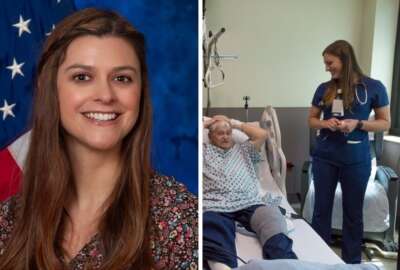VA researcher devoted his career to technology for assisting the disabled
This man has spent a career improving the lives of veterans and others with physical disabilities. He has overseen development of vastly improved wheelchairs and...
This man has spent a career improving the lives of veterans and others with physical disabilities. He has overseen development of vastly improved wheelchairs and prosthetic devices. Now he is an inductee to the Inventors Hall of Fame. The Federal Drive with Tom Temin spoke with Rory Cooper, VA senior research career scientist, Paralympian, and the man who directs the Human engineering Research Laboratories, a joint VA and University of Pittsburgh effort.
Interview Transcript:
Rory Cooper Academia has a constant influx of new people and young people. And you know, what they think about students is they’re like bees. They, they’re pollinators. They, they take classes from different professors in different departments, sometimes in different colleges or schools. We love to bring interns into our lab to expose them both to research and rehabilitation engineering and assistive technology, as well as to the VA and learning that the federal government does have, inventors and innovators and some amazing researchers and scientists and, they also bring their perspective because they’re not just coming from our affiliate university or our local universities, but they bring national and sometimes even a global perspective. And that keeps me on my toes, keeps all the other engineers and scientists here engaged. That’s a really important part of what makes us successful. And then the other thing that’s important is we are very focused on, participatory action design, engineering and research, which means engaging with our veterans or Americans with disabilities, caregivers and family members and as well as our health care providers, so that, you know, we are solving we are working on their problems. So, you know, we’re a very mission driven organization, more so than being an intellectual, curiosity driven organization.
Tom Temin And we talked about bringing, you know, new technology developments into the assistive area. But it also strikes me that many of the items and many of the capabilities developed in the assistive field actually have greater application for everyone. Just trivial example, every time I open a PDF, I hit that plus button so I can read the darn thing. And this started out as an enlargement capability was for 508 or for assistive technology. But millions more people can benefit from a lot of these things. Maybe instead of making the wheelchair seat more like an airline seat, it’s possible they could improve airline seats to be more like a wheelchair seat.
Rory Cooper There’s no question. You mentioned AI earlier, the early AI was the people disabilities were the early adopters, you know, word prediction, sentence prediction and all that was all first targeted at helping people with disabilities, especially who use like alternative augmentative communication devices for computers or, or computer access or for speech. That technology was originally they were the first adopters that I got to people just we used AI first. Yeah. It was I mean, generative AI, which was the early form of generative AI is being, you know, is people see is a revolution. But some of us have been working with it for 30 years. You know, there’s other things that are not as sophisticated, Text to speech is another one that was originally in speech to text that was also originally generated for people with disabilities and has become a mainstream tool, texting for that matter. Right. It’s also an accessibility feature that has become widely used, actually, the ability on your computer to enlarge the windows. Right. And do that was also a large in the text change the color of the text. All of that was originally accessibility features. And then other things like automatic door openers, curb cuts, wider doors. Those are all accessibility features. Like, you know, I tell people, you know, that there’s probably more delivery people use curb cuts than wheelchair users, for that matter. Probably more strollers use curb cuts and wheelchair users. So, we all benefit. And that’s the advantage when you think about the broader perspective. And even if it’s something specialized as a wheelchair, not many people use wheelchairs that don’t need that require one. But the technology that’s developed for wheelchairs understand the ergonomics, understanding better user interfaces, they spin out to other things. We work very early on in what’s called a zero-throw joystick, because they’re used in other applications as well now. From heavy equipment operation as well as to even computer access. So, in universal design, you think of if you can, if you catch the tail end, in other words, the super high performers, you know, the example of that is that’s one of the reasons the automotive industry invests in Formula One in NASCAR and Indy racing. And all of that is a lot of that technology that eventually trickles down into your regular car, such as, you know, disc brakes and ABS braking, power steering, all those sorts of things. Right. Even, now heads up displays and emergency warnings.
Tom Temin Yeah, that’s what Henry Ford the second said that race them on Sunday and then sell them on Monday.
Rory Cooper Yeah. So that one scale and then if you go to the other tail end, you know, people are very severely impaired, and they’ve developed technology that they can use and that benefits their inclusion in society and their participation in society. That benefits the middle as well. So, you kind of squeezed from both ends, right? You take sort of the superhuman athletes and the technology and those types of sports, and then they translate into everyday use. And then you take things on the other end. People that are on the other end of the bell curve, you can include them. That also helps everybody.
Tom Temin And a final question. You work in the area of assistive technologies. There are also rehabilitation rehabilitative technologies. Maybe just define the difference between those terms and how they also relate.
Rory Cooper So assistive technologies are typically those technologies you use up in in your home and community. And they you use of kind of long term. Rehabilitative technologies can be used are usually most in the in the hospital clinic or can be used actually extended in the home. But there to improve the rehabilitative technologies that help improve your function and reduce impairment. Whereas assistive technologies are to augment that function.
Tom Temin But they kind of interrelate.
Rory Cooper Strengthen one easily, right? But you could think of a rehabilitative technology, for example, as armor ammeter. Right. So, like a bicycle, you pedal which you know how to gain strength and physical stamina, but you might actually use a hand cycle to do the same thing, which, you know, becomes a sports and recreation device. So, they there’s certainly some overlap there. In that sense they might have got to go hand in hand. Right. You want to sort of maintain or improve function as you can. Right. And then at the same time augment function where you need to as well.
Tom Temin And being a Paralympian yourself, have you also discovered better ways of rehabilitation training for people that have these disabilities, whether they’re quadriplegic or paraplegic? The rehabilitative techniques have those improved also?
Rory Cooper Well, first, I mean, when I was injured today, the big change is we kind of transitioned to a survival model to a sports medicine model. So, helping people to achieve as much function as they desire, right. Need to have them set goals. And we work towards those goals rather than the, let’s just get you to you can take care of yourself and, and go home. Right. So, it’s really set higher goals. And so that’s been the big change from an attitude perspective. A little bit of a downside is that in the at least in the private sector, the length of stay of rehab has gotten so short that a lot of the rehab is transitioned from actually learning how to do it to how to learn further. So, you wind up responsible for doing a lot of your own rehab once you get out of the rehab setting.
Tom Temin And do you also keep track of developments in the ultimate rehabilitation, which would be spinal repair?
Rory Cooper So like we also follow, regenerative medicine. Right. That in general could be spinal even new organs. People are, we want to look at that. My philosophy is it’s been after, you know, 40 years of experiences that we’ve seen new disabilities. So, conditions that were fatal or didn’t exist at all become chronic conditions by trauma, was one of them. Right. That came really out of a post 911 era. And, you know, multiple sclerosis people are living typically much longer with multiple sclerosis than they did 40 years ago. Even diabetes is new people live well with diabetes. There’s been great technologies for, epilepsy and even spinal cord injury. I have lived longer today than the World War two veterans who were the first spinal cord injury survivors had lived when I became injured.
Copyright © 2025 Federal News Network. All rights reserved. This website is not intended for users located within the European Economic Area.
Tom Temin is host of the Federal Drive and has been providing insight on federal technology and management issues for more than 30 years.
Follow @tteminWFED






